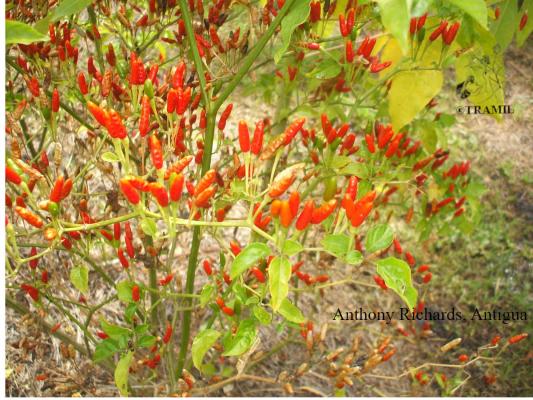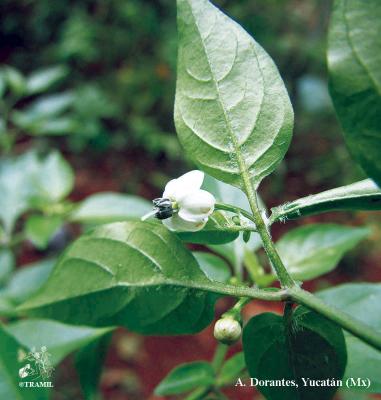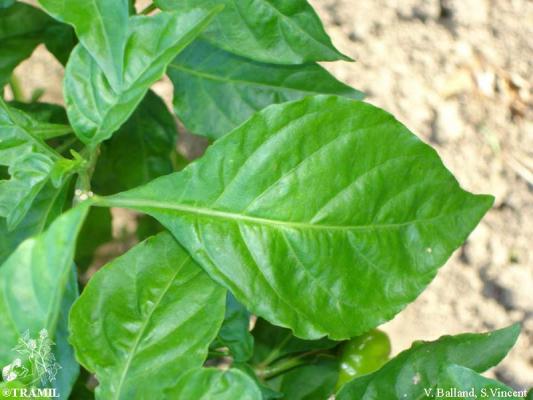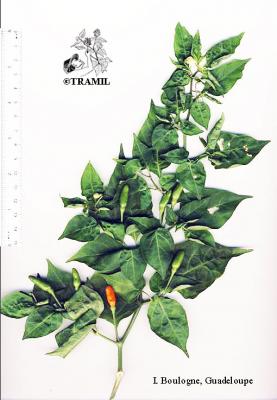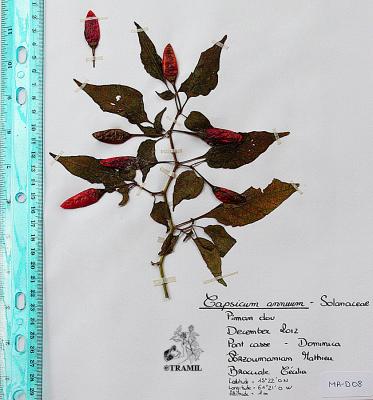Capsicum annuum
Noms vernaculaires
(dans les territoires avec usage significatif TRAMIL)
République dominicaine:
- ají caribe
Saint-Vincent-et-les-Grenadines:
- pepper bush
Haïti:
- piman caraïbe
- piman zwézo
Distribution géographique
Originaire d'Amérique tropicale. Cultivée dans les zones tropicales et tempérées.
Description botanique
Herbe ou arbuste à ramifications denses. Feuilles avec pétiole fin, solitaires ou par paires, ovalées ou ovalées-lancéolées, acuminées. Deux fleurs ou plus sur chaque noeud, rarement une; calice tronqué ou à très petits lobes; corolle blanche-verdâtre ou blanche-jaunâtre. Fruit rouge, de 1,5 à 3 cm de diamètre, ellipsoïde-lancéolé ou lancéolé, acuminé. Graines de couleur crème à jaunâtre.
Espèce très élastique par une grande quantité de cultivars possédant une grande variété de formes de fruits.
Voucher(s)
Jiménez, 17, JBSD
Balland, 033, JBSD
Pharmacopée
Ed.3References
1 GERMOSEN-ROBINEAU L, GERONIMO M, AMPARO C, 1984
Encuesta TRAMIL. enda-caribe, Santo Domingo, Rep. Dominicana.
2 WENIGER B, 1987-88
Encuesta TRAMIL. enda-caribe, Santo Domingo, Rep. Dominicana.
3 BALLAND V, GLASGOW A, SPRINGER F, GAYMES G, 2004
TRAMIL survey. enda-caribbean, IICA, UAG & U.PARIS XI, Saint Vincent.
4 GUTSU EV, KINTYA PK, LAZURIIEVSKII GV, Balashova nn, 1984
Steroid alkaloids and glycosides of Capsicum annuum L. Rast Resur 20(1):127-130.
5 POLITIS J, 1948
Distribution of chlorogenic acid in solanaceae and in the organs of these plants. Compt Rend 226:692-693.
6 TOMAS F, FERRERES F, 1980
Flavonoids from the leaves of Capsicum annuum (Solanaceae). I. Major components. Afinidad 37:517-518.
7 NOWACZYK L, 2011
Technlogical characteristics of fruit as an average of fruit as an average of soft-flesh Capsicum spp genotypes. Herba Polonica 57(2):38-44.
8 MARTINEZ MJ, BETANCOURT J, LOPEZ M, MOREJON Z, FUENTES V, MORON F, 2005
Antimicrobial effect of fresh leaves and their juice of Capsicum annuum. Informe TRAMIL. Laboratorio Central de Farmacología, Facultad de Ciencias Médicas “Dr. Salvador Allende”, La Habana, Cuba.
9 CICHEWICZ RH, THORPE PA, 1996
The antimicrobial properties of chili peppers (Capsicum species) and their uses in Mayan medicine. J Ethnopharmacol 52(2):61-70.
10 DUKE JA, 1992
Handbook of biologically active phytochemicals and their activities. Boca Ratón, USA: CRC Press.
11 DUKE JA, 2000
Chemicals and their biological activities in: Capsicum annuum L. Dr. Duke’s Phytochemical and Ethnobotanical Databases. USDA-ARS-NGRL, Beltsville Agricultural Research Center, Beltsville, USA, Aug.10,2000. URL: www.ars-grin.gov/cgi-bin/duke/farmacy2.pl
12 MARTINEZ MJ, BETANCOURT J, LOPEZ M, MOREJON Z, FUENTES V, MORON F, 2005
Irritabilidad dérmica primaria de hoja fresca en aceite de Capsicum annuum. Informe TRAMIL. Laboratorio Central de Farmacología, Facultad de Ciencias Médicas “Dr. Salvador Allende”, La Habana, Cuba.
13 MARTINEZ MJ, BETANCOURT J, LOPEZ M, MOREJON Z, FUENTES V, MORON F, 2005
Clases tóxicas agudas tópica de hoja fresca machacada de Capsicum annuum. Informe TRAMIL. Laboratorio Central de Farmacología, Facultad de Ciencias Médicas “Dr. Salvador Allende”, La Habana, Cuba.
14 DHAWAN BN, PATNAIK GK, RASTOGI RP, SINGH KK, TANDON JS, 1977
Screening of Indian plants for biological activity VI. Indian J Exp Biol 15(3):208-219.
15 GUZZO CA, LAZARUS GS, WERTH VP, 1996
Dermatological pharmacology. In: HARDMAN JG, GILMAN AG, LIMBIRD LE Eds. Goodman and Gilman’s the pharmacological basis of therapeutics. 9th ed. New York, USA: The McGraw-Hill Professional Publishing, International Edition.
16 PEISKER V, ARANGUREN ML, MONTERO DE ESPINOSA E, MORAES J, LEAL MS, SANZ J, 1995
Vademécum Internacional. Madrid, España: Medicom S.A.
17 CARBALLO A, 1995
Cálculo de concentración y dosis de las drogas vegetales TRAMIL: Mensuraciones farmacognósticas y aproximaciones técnico-clínicas. Laboratorio provincial de producción de medicamentos, Sancti Spiritus, Cuba.




